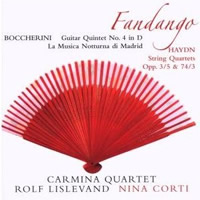| Review by Beagle January 21, 2010 (4 of 7 found this review helpful)
|
Performance:  Sonics: Sonics:  |
I sigh when I think of this disc, I had such high hopes for it: two Haydn quartets and a new rendition of Boccherini’s quirky Nachtmusik. Okay… only one Haydn quartet; Joe claimed (and obviously wished) he’d written Opus 3, especially the ‘Serenade’ – but he didn’t. All the more reason to be pleasantly surprised by its appearance on SACD when numerous eckt-Haydn quartets still await.
With the sole exception of Nina Corti’s virtuoso performance on castanets, my disappointment is thorough. Who would mistake the Carmina Quartet’s performance of Opus 3 no. 5 for Haydn? They make Padre Romanus Hoffstetter’s quartet actually sound like it was written by some small town priest. The notes lie flat on the stave without humour or animation; the famously beautiful ‘serenade’ sounds bourgeois and saccharine.
Boccherini’s Fandango is leavened by Corti’s castanets, but needs more rehearsals. And Boccherini’s magical sound-painting of bells, soldiers and drunks? Disjointed cacophony. There are sounds here that I didn’t think strings could make, one like a strangled cow. It need not be thus; the performances on Die Röhre, The Tube - Stuttgarter Kammerorchester and Boccherini: Fandango & Sinfonias - Savall are totally delightful.
Much of my unhappiness is over lack of ‘ensemble’, that subtle integration of motion which mere microseconds can make or break. I admit that Haydn’s “Ritter’ quartet fares better than the Hoffstetter and Boccherini; it at least sounds thoroughly rehearsed.
But what makes me grimace is the string tone on this recording: nasal highs and muffled lows. If you will pardon a visual image: the violins protrude like metal springs from an overworn sofa, while the viola and cello are smothered beneath chintz and horsehair padding. The microphones are obviously unbalanced, but I have a strong feeling that the primarius is stinting on vibrato, thus producing a steely cold tone. I scanned the liner-notes to see if he was playing a baroque fiddle, but instruments are not mentioned. Perhaps the balance was upset by inclusion of guitar in all of these works except for the ‘Ritter’. For raw sound energy, a guitar simply can’t compete with bowed strings, and microphone placement here didn’t rescue it from sounding like an afterthought.
I am so underwhelmed.
|
Was this review helpful to you?
yes |
no
|
|
| Review by Fasolt April 2, 2010 (4 of 4 found this review helpful)
|
Performance:  Sonics: Sonics:  |
Wow, Beagle, it's amazing how tastes differ - I'm a big fan of this recording, and of the Carmina's recorded repertoire in general. They have a lot of "air" and "fire" energy (think Martha Argerich), which, in the case of their Opus 3 could conceivably be so light-footed that it doesn't register on someone's pleasure-o-meter - for instance, my great aunt Dorothy, who loves to read Opus 3 at half tempo with her amateur quartet. Otherwise, I simply can't understand how you fail to respond to this elegant, charming rendition - in fact, the Opus 3 is for me the highlight of a very lively, sunny, unusual recording.
In terms of the recorded sound, this is indeed somewhat "sharper" than some of their best recordings (sounds like a small recording space?); even so, the signature sweetness of the Carminas I know from their decades recording for DENON shines through.
I don't think the Carminas use baroque instruments, but they are certainly at the forefront of something like the "post Harnoncourt" wave of musicians: they have swallowed the baroque movement whole, digested it, and are currently producing their own inimitable creative product, which seems not to be to quite everyone's taste (for example, again, my great aunt Dorothy, who also loves her vibrato), but is dynamic and unforgettable. The experimental nature of this recording (including the unconventional integration of the guitar) is a departure from the Carmina's traditional DENON recordings, but a welcome change on the otherwise rather stuffy quartet scene.
|
Was this review helpful to you?
yes |
no
|
|

